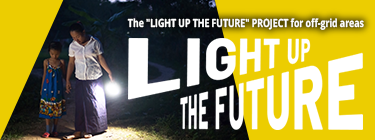Off-grid Solutions Project
 Indonesia Activity Report
Indonesia Activity Report
Started growing and processing the superfood “moringa”
At its training center, Yayasan Dian Desa is providing a variety of training programs to local residents. For example, they grow the much-talked-about superfood moringa, and other crops. Currently, they are carrying out tests to dry harvested moringa leaves with room heaters powered by electricity generated by PSS*. They will work on developing local products utilizing dried moringa leaves (September 2018).

Organic fertilizer production
Since the Kalimantan Island consists of reddish soil inappropriate for agriculture, it is required to improve the soil by using fertilizers. Therefore, the training center is providing a program to produce an organic fertilizer to grow quality vegetables. The process is to cut branches and leaves of leguminous Mucuna trees indigenous to the island, add bacteria, and age them. Surrounding villages started to test this fertilizer in their fields. Currently, purchased chemical fertilizers are generally used. By switching to an organic fertilizer, it is expected to reduce both environmental and household economic burdens.

Superfood “moringa” growing and processing
Moringa grown from seedlings or cuttings are harvested around six months later, for sorting, cleaning, and drying. Leaf drying tests are underway to develop local products using the superfood. Efforts are being made to establish manufacturing processes that will ensure stable quality since room temperature must be kept at 40˚C or below to prevent leaf fermentation or discoloring. As moringa is not familiar or eaten in the community, some people are participating training to learn how to make moringa useful to develop their community.

Local residents are carrying out tests to produce fried crackers by mixing dough made from the freshwater fish caught in the river with dried moringa, which have a slightly bitter flavor. The product is being developed by leveraging moringa and characteristics of the region along the large river where large quantity of freshwater fish are available.
Collecting and processing honey







